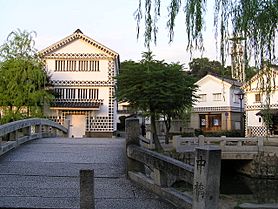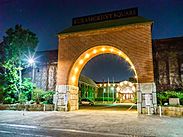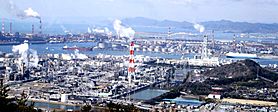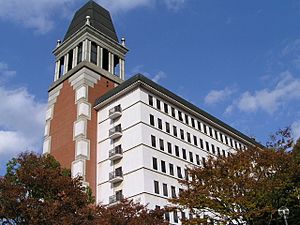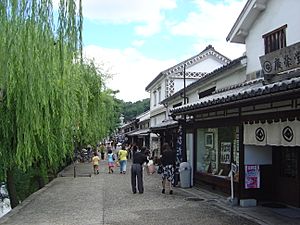Kurashiki facts for kids
Quick facts for kids
Kurashiki
倉敷市
|
|||||||||||||
|---|---|---|---|---|---|---|---|---|---|---|---|---|---|
|
|||||||||||||
|
|||||||||||||
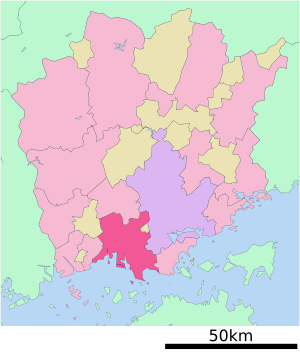 |
|||||||||||||
| Country | Japan | ||||||||||||
| Region | Chūgoku (San'yō) | ||||||||||||
| Prefecture | Okayama | ||||||||||||
| Area | |||||||||||||
| • Total | 355.63 km2 (137.31 sq mi) | ||||||||||||
| Population
(March 31, 2023)
|
|||||||||||||
| • Total | 478,651 | ||||||||||||
| • Density | 1,345.924/km2 (3,485.93/sq mi) | ||||||||||||
| Time zone | UTC+09:00 (JST) | ||||||||||||
| City hall address | 640 Nishinakashinden, Kurashiki-shi, Okayama-ken 710-8565 | ||||||||||||
| Climate | Cfa | ||||||||||||
|
|||||||||||||
Kurashiki (倉敷市, Kurashiki-shi) is a cool city located in Okayama Prefecture, Japan. As of March 31, 2023, about 478,651 people live there. The city covers an area of 355.63 square kilometers. It's a place with a rich history and a mix of old traditions and modern industries.
Contents
- Geography: Where is Kurashiki?
- People of Kurashiki: How Many Live Here?
- History: A Look Back in Time
- Economy: What Does Kurashiki Make?
- Education: Schools and Universities
- Transportation: Getting Around
- Sister Cities: Friends Around the World
- Local Attractions: What to See and Do
- Sports: Get Active in Kurashiki!
- Notable People from Kurashiki
- See also
Geography: Where is Kurashiki?
Kurashiki is in the south-central part of Okayama Prefecture. The Takahashi River flows through the city and into the Seto Inland Sea. Most of the city's flat areas are made of land that was once underwater, called reclaimed land, or alluvial plains, which are flat lands formed by rivers.
You might notice many places in Kurashiki have "island" (shima or jima) in their names, like Kojima or Tamashima. That's because these areas used to be actual islands! Over time, people connected them to the mainland by adding more land. Kurashiki is right next to Okayama City, the capital of the prefecture.
Climate: What's the Weather Like?
Kurashiki has a humid subtropical climate. This means it has hot, humid summers and mild winters. The average temperature each year is about 15.8 degrees Celsius (60.4 degrees Fahrenheit). September is usually the wettest month. The hottest month is August, with temperatures around 27.9 degrees Celsius (82.2 degrees Fahrenheit). January is the coldest, at about 4.6 degrees Celsius (40.3 degrees Fahrenheit).
People of Kurashiki: How Many Live Here?
According to the Japanese census, Kurashiki had 474,592 people living there in 2020. The city has been counting its population since 1960. You can see how the population has grown over the years:
| Historical population | ||
|---|---|---|
| Year | Pop. | ±% |
| 1960 | 286,902 | — |
| 1965 | 308,908 | +7.7% |
| 1970 | 374,385 | +21.2% |
| 1975 | 417,750 | +11.6% |
| 1980 | 432,171 | +3.5% |
| 1985 | 443,721 | +2.7% |
| 1990 | 445,059 | +0.3% |
| 1995 | 453,618 | +1.9% |
| 2000 | 460,869 | +1.6% |
| 2005 | 469,377 | +1.8% |
| 2010 | 475,421 | +1.3% |
| 2015 | 477,118 | +0.4% |
| 2020 | 474,592 | −0.5% |
| Kurashiki population statistics | ||
History: A Look Back in Time
The Kurashiki area has a very long history! People have lived here for over 20,000 years, even during the Japanese Paleolithic period. You can find ancient sites from the Jōmon period (shell middens, which are old piles of shells and trash), Yayoi period (old village remains), and Kofun period (large burial mounds called kofun).
During the Edo Period (1603-1868), the old town and port of Kurashiki were very important. The government directly controlled this area. It was a central place for collecting rice taxes. This is why you see those famous white-walled, black-tiled warehouses – they were built to store goods like rice! Local businesses thrived, including making cotton cloth and salt.
Kurashiki officially became a town in 1891 and then a city in 1928. In 2005, two nearby towns, Mabi and Funao, joined Kurashiki. In 2002, Kurashiki was named a "Core city," which means it has more power to make its own local decisions.
Economy: What Does Kurashiki Make?
Kurashiki is the second-largest city in Okayama Prefecture. Its economy is a mix of different things:
- Shopping and Business: Many shops and businesses operate here.
- Farming: Agriculture is also important.
- Heavy Industry: A big part of the economy comes from large factories. The Mizushima Rinkai Industrial Area is one of Japan's top industrial zones. It has factories that make things like chemicals, steel, cars, and even ships!
Education: Schools and Universities
Kurashiki is a great place for learning! It has many schools and universities:
- Universities: There are several private universities and one public university, Kurashiki City College. These schools offer many different subjects, including medicine and arts.
- Schools: The city has 62 public elementary schools and 26 public junior high schools. There are also 15 public high schools (some run by the city, some by the prefecture) and four private high schools.
Transportation: Getting Around
Getting around Kurashiki and to other cities is easy thanks to its good transportation system.
Trains
You can travel by train using several lines:
- JR West - San'yō Shinkansen: This is Japan's famous bullet train!
- Shin-Kurashiki
- JR West - San'yō Main Line
- Nakashō - Kurashiki - Nishiachi - Shin-Kurashiki
- JR West - Hakubi Line
- Kurashiki
- Mizushima Rinkai Railway - Mizushima Main Line
- Kurashiki-shi - Kyūjōmae - Nishitomii - Fukui - Urada - Yayoi - Sakae - Tokiwa - Mizushima - Mitsubishi-jikō-mae
- Ibara Railway Company - Ibara Line
- Kawabejuku - Kibinomakibi - Bitchū-Kurese
Highways
Major highways also connect Kurashiki to other parts of Japan:
 San'yō Expressway
San'yō Expressway Seto-Chūō Expressway
Seto-Chūō Expressway National Route 2
National Route 2 National Route 429
National Route 429 National Route 430
National Route 430 National Route 486
National Route 486
Sister Cities: Friends Around the World
Kurashiki has special friendships with cities in other countries. These are called "sister cities" and they help promote cultural exchange and understanding.
 Sankt Pölten, Austria (since 1957)
Sankt Pölten, Austria (since 1957) Kansas City, Missouri, United States (since 1972)
Kansas City, Missouri, United States (since 1972) Christchurch, New Zealand (since 1973)
Christchurch, New Zealand (since 1973) Zhenjiang, Jiangsu, China (since 1997)
Zhenjiang, Jiangsu, China (since 1997)
Local Attractions: What to See and Do
Kurashiki is famous for its beautiful and historic places!
Ohara Museum of Art
This museum is super special because it was Japan's very first museum dedicated to Western art. It was started in 1930 by a businessman named Magosaburō Ōhara. Inside, you can see amazing paintings by famous artists like El Greco, Monet, Matisse, and Renoir. The museum also has great examples of Asian and modern art.
Bikan Historical Area
This is the old merchant quarter, and it's like stepping back in time! You'll see many beautiful 17th-century wooden warehouses, called kura, which are painted white with traditional black roof tiles. They stand along a lovely canal lined with weeping willow trees and filled with colorful koi fish. To keep the old-fashioned look, there are no electric poles in this area.
Great Seto Bridge
This impressive bridge connects Kurashiki to Sakaide in Kagawa Prefecture, stretching across the Seto Inland Sea. It's a huge engineering marvel!
National Historic Sites
Kurashiki is home to important historical places:
- Tatetsuki Site: These are ruins from the Yayoi period.
- Yata Ōtsuka Kofun: This is a large burial mound from the Kofun period.
Sports: Get Active in Kurashiki!
Kurashiki has a lively sports scene with several teams:
- JX Nippon Oil & Energy Mizushima F.C. - Soccer
- Kurashiki Oceans - Baseball
- Kurashiki Peach Jacks - Baseball
- Mitsubishi Motors Mizushima FC - Soccer
Some professional soccer teams, like Vissel Kobe and Fagiano Okayama, actually started in Kurashiki before moving to other cities!
Notable People from Kurashiki
Many talented people come from Kurashiki, including:
- Senichi Hoshino, a famous baseball player
- Hisako Kanemoto, a voice actress
- Kibi no Makibi, an important scholar and noble from the Nara period
- Megumi, an actress
- Magosaburō Ōhara, the businessman who founded the Ohara Museum of Art
- Daisuke Takahashi, a well-known figure skater
- Keiji Tanaka, another talented figure skater
- Joichiro Tatsuyoshi, a boxer
See also
 In Spanish: Kurashiki para niños
In Spanish: Kurashiki para niños


